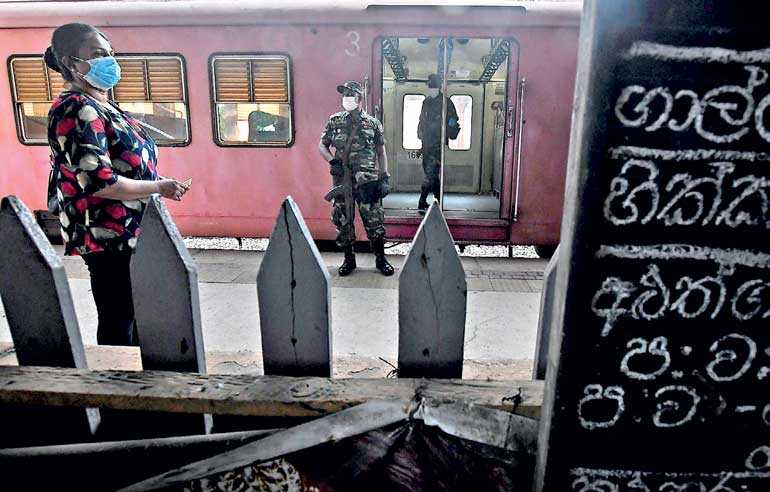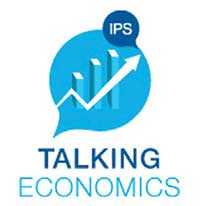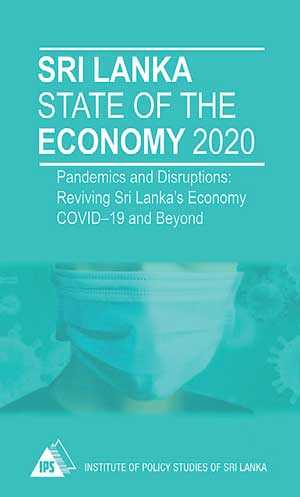Monday Feb 24, 2025
Monday Feb 24, 2025
Tuesday, 13 October 2020 01:14 - - {{hitsCtrl.values.hits}}

by Institute of Policy Studies
As Sri Lanka’s recent surge in coronavirus (COVID-19) infections shows, there is still no end in sight to the disruptive effects of the virus. Robust policies to deal with the related economic uncertainties can help to contain the fallout without major run long costs for the Sri Lankan economy. These involve short-term emergency actions and more medium-term stabilisation measures.
Countries are acting alone amidst a global leadership vacuum
With global hyper-connectedness at an all-time high, the rapid transmission of COVID-19 across borders is no surprise. If a more inter-connected world was expected to also deliver a strong coordinated global response, the outcome has been disappointing. In most countries, the instinctive response has been to retreat inwards and act alone.
The vacuum in global leadership to address the health and economic fallout of COVID-19 is not helpful. All available estimates suggest that the world economy will experience its worst-ever downturn since the Second World War.
Unlike other major shocks in recent history, COVID-19 is both a supply and demand shock, with the economic effects from reduced spending expected to be larger than those coming from supply chain and labour market disruptions.
Fiscal policy is the more effective lever to counteract a slump
Fiscal policy as the dominant lever is a continuum of an economic paradigm shift since the 2008 global financial crisis. With weak growth and low inflation and no further room for interest rate reductions, fiscal interventions can act as the stimulus-of-last-resort. Today, as central banks resort to direct financing of fiscal spending, the lines between fiscal policy – i.e. government debt management – and monetary policy is becoming rather blurred.
The ability of advanced and developing countries to enact fiscal and monetary tools differ. Advanced economies can manage large funding gaps better. Not only are they able to borrow more cheaply in their own currencies, but some, as issuers of international reserve currencies, can print money with limited risks.
Among developing countries too, the risks are spread. Those with higher initial public debt levels – especially, mounting volumes denominated in foreign currency – need to be concerned more than ever about the economic fallout. Sri Lanka is one such country, with particularly weak initial conditions.
Health successes offer Sri Lanka a head start on economic recovery and must not be compromised
Sri Lanka earned international plaudits for its handling of COVID-19. The recent spurt in infections must not be allowed to compromise the head start, which together with an assured period of political stability, can encourage more investment, create jobs and boost growth. Thus, while an economic contraction in 2020 seems almost inevitable, a sharp V-shaped recovery thereafter is also a very real possibility.
Tax cuts meant to encourage spending and investment and low interest rates to help maintain demand and keep government borrowing costs down, make possible some attractive short-term numbers. Such a recovery presents both an opportunity and a challenge. It presents an opportunity to lay the foundation for sustained forward long-term growth; the challenge is to manage the stimulus measures that promise to test the resilience of a heavily indebted economy.
Sri Lanka’s stimulus efforts will combat immediate deflationary shock but can stoke inflation
So far, the crisis-fighting economic stimulus package leans lopsidedly on monetary policy. To mitigate risks of the stimulus spilling over into more imports, a widening trade deficit and downward pressure on the exchange rate, curbs on a range of imports as well as some capital outflows, have been imposed as temporary short-term measures.
These must be seen as emergency actions necessary to combat the immediate deflationary shock. If persisted with for any length of time, the monetary-financed stimulus can push up inflation.
Credit growth to the private sector remains sluggish at 5.2% as of August 2020; this is to be expected with depressed labour markets and lower household spending as they smoothen consumption behaviour owing to economic uncertainty.
But as banks expand their balance sheets, the possibility of more money chasing fewer goods and services and stoking inflationary pressures is very real. Sri Lanka’s money supply growth is picking up sharply, at 17.5% in August 2020 compared to 7% at end 2019.
Beyond the short-term, aggregate demand growth can quickly outpace supply growth and fuel price pressures, especially when inflation expectations are not as well anchored.
Inflation reduces the real value of debt, benefitting the government, but not without major costs for the economy. Sri Lanka’s structurally weak economic growth of the past decade – concentrated on a narrow base of non-tradable sectors like construction – provides ample examples of excessive money expansion finding its way to asset and real estate bubbles, leading to undesirable swings in interest rates and economic activity.
Tax and spending policies must be assessed for future preparedness
Detailed assessments of tax and spending policies to help by-pass such macroeconomic risks are necessary. While the government has shown creditable political determination to curb spending, Sri Lanka can no longer be a low tax and low spend economy. The country does poorly already against its Asian emerging market competitors – raising only a half in revenues and spending only a half of what they do.
As its population ages and growth in the labour force slows, Sri Lanka must rely on a skilled workforce and adequate infrastructure to compete with technology-driven growth as an aspiring upper-middle-income country. All these require a solid foundation from healthy public finances.
With sizeable foreign debt rollovers in the pipeline, any persistent signs of macroeconomic instability, and accompanying rating downgrades, carry heavy risks for debt sustainability.
The COVID-19 fallout is seeing investor flight to safe havens, resulting in sharp increases to risk premiums or borrowing costs. Sri Lanka too, is high on the watch-list given its back-to-back foreign debt settlements to the tune of $ 3-4 billion with only $ 6.7 billion official reserves in hand as of September 2020.Under these conditions, a flexible exchange rate – with limited intervention to smoothen excessive volatility – seems to be the surer bet. Defending an exchange rate that is not reflective of economic fundamentals will only lead to a futile rundown of official reserves as a short-term solution.
Beyond the short-term, restricting trade is also self-defeating. While curbs on motor vehicle imports to deter non-essential expenditures at this point are reasonable, external sector pressures will need to be addressed directly over time. Sri Lanka is not an exception in re-examining trade policies to support livelihoods, food security and other priorities in the wake of COVID-19.
For the country though, its indebtedness makes exports vital for a steady stream of foreign currency earnings to build up reserves and ward off speculators. As global supply chain networks take new shape – possibly in the form of more compact regional networks – the country must not lose out by an unwieldy import tariff regime.
Policy choices matter
Once the immediate COVID-19 crisis recedes, Sri Lanka has a very real opportunity to make policy choices that will play a critical role in determining robust outcomes and help greatly to mitigate risks of disruptive impacts from similar crises in the future. These disruptive impacts hold multiple socio-economic dimensions. For Sri Lanka, a high 68% of the workforce are in informal employment and with only 29% of the country’s workforce covered by social protection, the risks of widening existing income disparities are elevated.
In the mitigation and recovery phases, disparities can become entrenched. Only 23% of Sri Lankan households own either a desktop or a laptop computer, limiting options to work from home or access alternative means of education. Thus, enacting an effective economic recovery is vital to swiftly close the gap between pre and post-COVID-19 output losses – and hence, of incomes and standards of living.
These and many other issues are discussed in ‘Sri Lanka: State of the Economy 2020’ report which examines the policy contours of a country that builds back better beyond COVID-19.
Discover Kapruka, the leading online shopping platform in Sri Lanka, where you can conveniently send Gifts and Flowers to your loved ones for any event including Valentine ’s Day. Explore a wide range of popular Shopping Categories on Kapruka, including Toys, Groceries, Electronics, Birthday Cakes, Fruits, Chocolates, Flower Bouquets, Clothing, Watches, Lingerie, Gift Sets and Jewellery. Also if you’re interested in selling with Kapruka, Partner Central by Kapruka is the best solution to start with. Moreover, through Kapruka Global Shop, you can also enjoy the convenience of purchasing products from renowned platforms like Amazon and eBay and have them delivered to Sri Lanka.
Discover Kapruka, the leading online shopping platform in Sri Lanka, where you can conveniently send Gifts and Flowers to your loved ones for any event including Valentine ’s Day. Explore a wide range of popular Shopping Categories on Kapruka, including Toys, Groceries, Electronics, Birthday Cakes, Fruits, Chocolates, Flower Bouquets, Clothing, Watches, Lingerie, Gift Sets and Jewellery. Also if you’re interested in selling with Kapruka, Partner Central by Kapruka is the best solution to start with. Moreover, through Kapruka Global Shop, you can also enjoy the convenience of purchasing products from renowned platforms like Amazon and eBay and have them delivered to Sri Lanka.